Yoga is one of the best ways to increase flexibility while challenging your balance!
Yoga might be difficult to start and get a hang of.
However, undoubtedly, yoga is the ultimate way to detoxify your mind and body with everyday stress.
And yoga linked with flexibility is the most sensible link ever!
In a world where people keep themselves glued to the screen, sit for 9-10 hrs, stress is inevitable. And as a result, it not only happens to kill your peace of mind but also the tenderness of your muscles.
In this scenario, practicing yoga religiously can be the cure your body looking for.
However, you must know to get desirable results, one must PRACTICE yoga regularly.
Today, we’ll tell you how to use yoga to increase flexibility for beginners the easy way and what are some yoga poses and tips that will help you achieve that with safety!
So, continue reading to find your path to flexibility.
How Does Yoga Increase Flexibility?
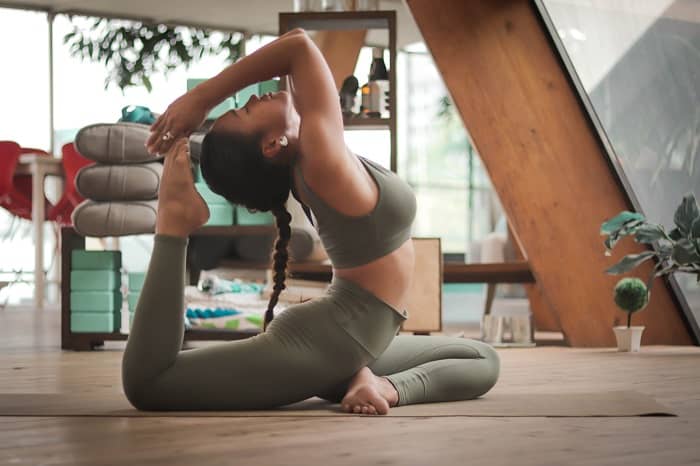
Yoga and flexibility are undoubtedly related.
It’s tried and tested that regular practice of yoga brings flexibility to your body.
With slow movements and better concentration, yoga poses help create deep connections with the tissues which when stretched, helps them relax.
Moreover, with the intention of muscle flexibility, when different yoga poses are linked together with deep concentration & focused breathing, it warms up the muscles and allows for a deeper stretch of tissues and tendons.
With just 10 minutes of dedicated yoga practice, you can improve your flexibility and:
- Get rid of bad posture
- Can level up your confidence because of attractive posture
- Reduce of chances of getting hurt because of better motion.
Hence, yoga for flexibility and strength is truly dynamic and effective when practiced regularly and correctly.
8 Beginner Yoga Poses for Flexibility
Some of the best yoga poses for beginners are:
- Intense Side Stretch
- Head to Knee
- Bow Pose
- Low Lunge
- Wide-Angle Seated Forward Bend
#1. Intense Side Stretch (Parsvottanasana)
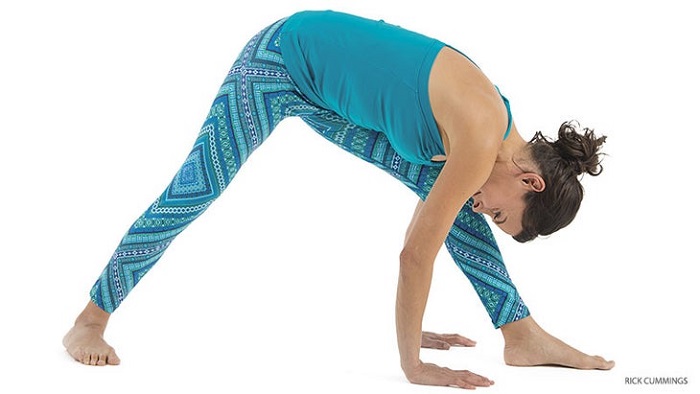
This forward bend stretches when performed regularly, benefits your posture, balance, and digestion.
It is performed in standing position and stretches your spine, legs, shoulders and hips. It also helps create an alignment in body and mind.
How to Do Intense Side Stretch:
- Stand straight and bring your left foot ahead facing forward and your right foot back, raising your toes at a small angle.
- Keep your hips to face forward and place your hands on your hips
- Slowly bend at your hips to fold your torso forward
- Tuck your chin into your chest and drop your hands to the ground or place them on a block.
- Hold this pose for nearly 1 minute.
- Change the position of your feet and repeat the same steps.
#2. Head to Knee (Janu Sirsasana)
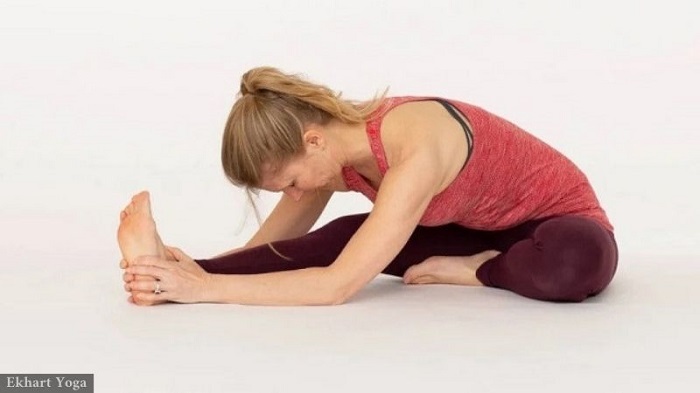
This is one of the best beginner yoga to increase flexibility.
It stretches the back and legs muscles. A slow and regular practice of this pose can help you achieve flexibility of a greater level.
How to Do Head to Knee Pose:
- Sit on the mat in an easy pose.
- Extend your right leg, and place the bottom of your left foot on the inner side of your right thigh.
- Inhale while lifting your arms overhead, stretching your waistline.
- Maintaining the length of your stretched spine, exhale and bend towards your outstretched leg.
- Interlock your fingers around the foot and try to place your head against the knee. (At the beginning, you can bend your right knee to avoid pain)
- Maintain the pose for 3-6 breaths. Then continue with another leg.
#3. Bow Pose (Dhanurasana)
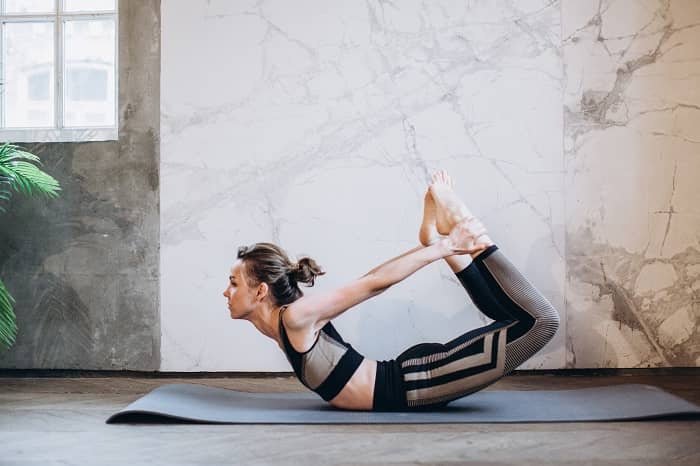
If you have to sit for long hours to work, this pose is what you need.
It stretches the hip flexors and strengthens the upper and lower body both.
It can help increase flexibility in your core muscles, back, chest, glutes, and legs.
Bow pose opens your shoulders, relives tightness of the lower back, and improves your posture.
How to Do Bow Pose:
- Start by lying on your stomach.
- Keep your knees hip-width apart and your arms at your side.
- Lift up your knees and thighs and hold them with your hands on the surface of your ankles.
- Try to lift your thighs and torso off the bottom, but don’t push beyond what’s comfortable.
- Keep looking forward while taking long, deep breaths.
- Try to hold the position for 15-30 seconds, then release. Repeat 1 to 2 times.
#4. Low Lunge (Anjaneyasana)
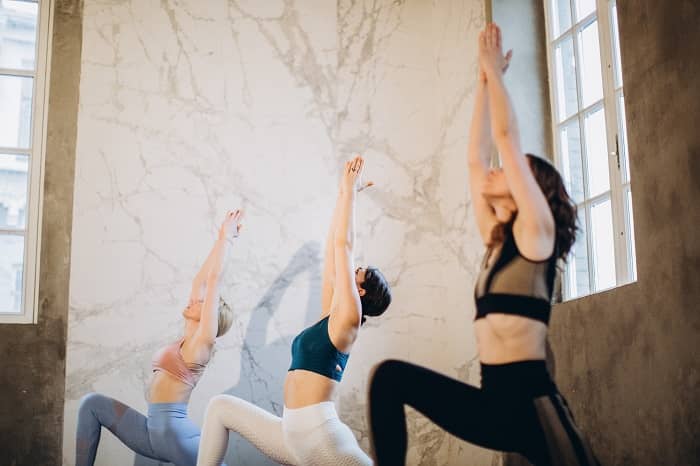
This pose is ideal to lengthen your spine, open your hips, and build muscle strength. It encourages motion in your lower body.
Interestingly, it is recommended for both athletes and those who are tied to sitting jobs.
How to Do Low Lunge:
- To begin with, kneel on the ground on your left knee.
- Bend your right knee and place your right foot flat on the bottom.
- Slide back your left foot until you feel a nice relaxing stretch.
- As you inhale, lengthen through your spine and straighten your head.
- Slowly, lift up your torso and arms above your head. Or, you can extend your arms to the side, perpendicular to the ground.
- Try to hold this position for 15-30 seconds.
- Switch legs and repeat.
- Prevent your front knee from moving past your ankle.
- Maintain square hips by drawing your back hip forward.
#5. Wide-Angle Seated Forward Bend (Upavistha Konasana)
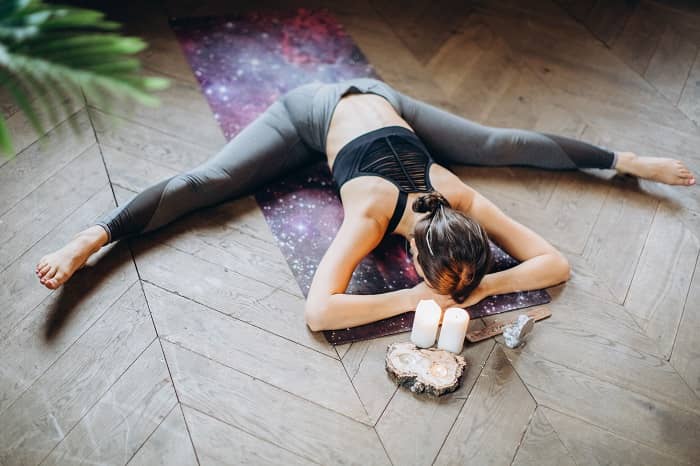
This is a forward bend that can help open up your groin, hips, and lower back while also boosting flexibility in your hamstrings and calves.
It’s often performed at the last of your yoga routine.
How to Do Wide-Angle Seated Forward Bend:
- Sit on the ground with your legs wide open as far as possible.
- Without allowing you to bend your spine, slowly start to extend your arms overhead.
- Hinge at your hip joints to fold forward, walking your hands forward towards your feet as far as you can. Hold this position for up to5 – 10 breaths.
- If your toes bend to the edges, move your legs in closer. Your toes should face straight up as if you’re pressing the soles of your feet.
- You can sit on a foam block or cushion to make the pelvis bend smooth.
Final Thoughts
Your lifestyle has a lot to do with your muscles.
That is to say, long working hours, uneven sleep schedule, sitting jobs, tension, and stress all affect your muscles and create stiffness.
If you’re dealing with the same, it’s high time you should try the above-mentioned full-body yoga workout for beginners and achieve getter flexibility along with peaceful sleeping.
And people using yoga to increase flexibility and strength will agree and can even tell you that how adopting yoga has been a game-changer for them and why you must trust it too.
Yoga calms your mind, relaxes your nerves, and warms your muscles for better stretch and flexibility.
“Yoga is the fountain of youth. You’re only as young as your spine is flexible.” ― Bob Harper
RELATED:
Benefits of Power Yoga for Weight Loss | 11 Poses With Pictures